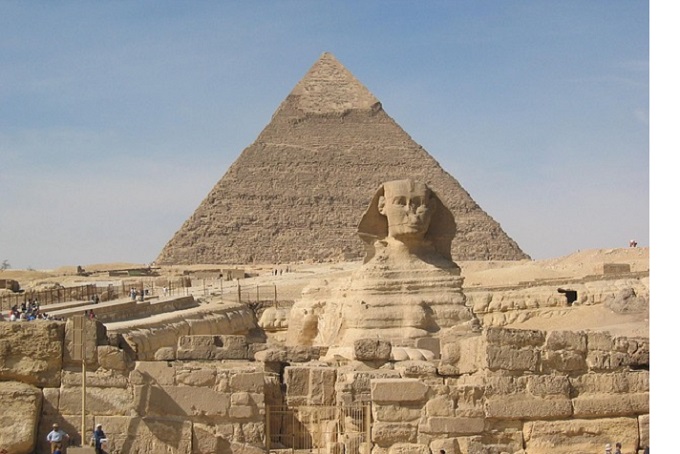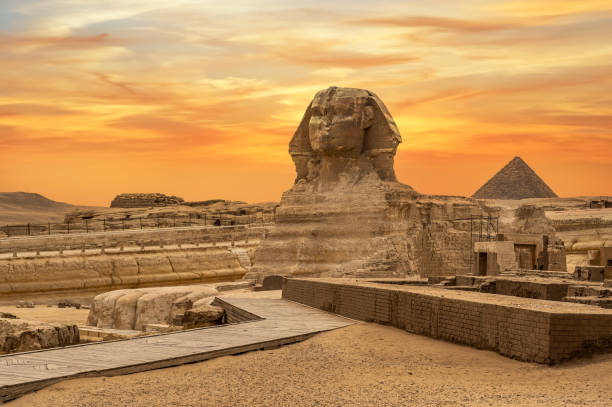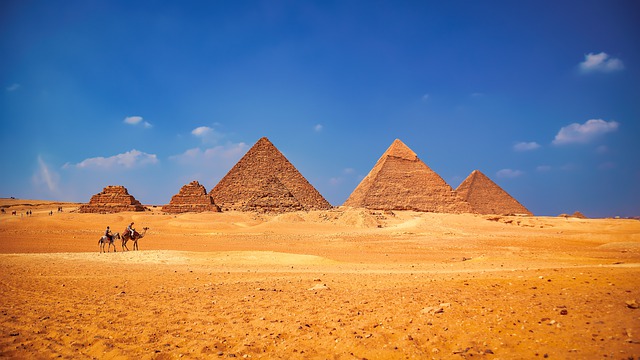Ancient technologies, supernatural forces, and other mysteries of the Cheops pyramid

Egypt is one of the most ancient countries in the history of humankind. It originated at the source of the Nile about 6000 years ago: during this time, the Egyptians managed to prove themselves as great conquerors, create several languages and a whole pantheon of gods with their histories, traditions, and myths, advance science and technology to unprecedented, by the standards of the Ancient World, heights and create amazing, truly unique monuments of art, which even now, thousands of years later, annually come to see about three million tourists from all over the world. The pyramid of Cheops, erected by the nephew of the great and cruel ruler, Hemiunu, is rightfully considered the most legendary cultural heritage of the ancient Egyptians in honor of his ancestor.
The desert mass has been pressing on the ground weighing about 6.5 million tons for 4.5 thousand years, with all its appearance reminding of the former greatness of the ancient Pharaoh. Even now, in the era of digital technologies and global digitalization, scientists continue to puzzle over the riddles that the ancient Egyptians left in the mysterious narrow corridors of the Cheops pyramid 45 centuries ago.
Exact geometry and sacred knowledge

Outwardly, the pyramid of Cheops does not differ much from other Egyptian pyramids: the same pointed, yellow and directed upward. However, if we turn to dry numbers, we can notice many strange coincidences that, willy-nilly, make us think that the ancient Egyptians knew much more than we used to think about them.
The faces of the Cheops pyramid are located clearly on the four cardinal points, and the length of each of the pyramid’s bases is exactly 230 meters with an error of up to 10 centimeters. This means that the ancient Egyptians built the huge tomb, which did not even have a close idea of trigonometry, from millions of granite blocks weighing about 2.5 tons each, ideally equilateral.
The length of 230 meters is not accidental: the fact is that the distance at that time, in the absence of the metric system, was measured with elbows, where each “cubit” took about 0.635 meters; therefore, each base of the Cheops pyramid consists of 365 cubits with a small error, which coincides with the number of days in a year. The question of how the engineers who existed 45 centuries ago managed to keep the proportions of such a large-scale structure so evenly remains open to this day. But believe me, this is far from the most fantastic thing that can be noticed if you take a closer look at the “numbers” of the Cheops pyramid.
The original height of the Pharaoh’s tomb is 146.6 meters, which is one-millionth of the minimum distance from the Earth to the Sun. Of course, this can be called a coincidence, but we must not forget that the sun god Ra, according to Egyptian mythology, is the father of all deities and the creator of the world. And suppose we add to this the fact that the Egyptians deeply believed in the afterlife and tried in every possible way to please the gods with righteous life and sacrifices. In that case, we can say that an amazing accident may not be as accidental as it seems at first glance.
The pyramid of Cheops is a legendary tombstone or storage for grain

According to official data, the construction of the Cheops pyramid took 20 years and a huge amount of resources. Still, the true purpose of this unprecedented structure in terms of its size and volume remains unknown. The most common version is that the cruel Pharaoh Cheops, who wished to perpetuate his 50-year rule of Egypt effectively, commissioned to erect a beautiful tomb for himself to go on a grand scale to another world. This is evidenced by the Egyptian name of the pyramid – “Horizon Khufu,” or simply Khufu (aka Cheops). Indeed, inside the pyramid, there is a burial room, moreover, not one, as well as many passages and tunnels so that the soul of Cheops can find its way to the stars after burial. Considering the colossal belief of the ancient Egyptians in the afterlife, this scenario is quite real.
Rich people and, as a rule, pharaohs spent huge money on the construction of tombs and pyramids, decorated their mausoleums with drawings and jewelry, ordered exquisite sarcophagi and burial masks for themselves, and after the death of their wealth and even sometimes slaves, they were buried together with their owner, tightly sealing still-living people in huge sand tombstones.
Indeed, the pyramid of Cheops has fairly reliable protection from thieves, but the catch is that the scientists did not find any treasures, the lid of the sarcophagus, or even the mummy of Cheops in his tomb.
Hence, another version follows that the pyramid was used as a storage for a huge amount of grain prepared by the Egyptians in case of famine. This theory is confirmed by the events described in the Bible. According to history, Joseph, the son of Jacob, unraveled the prophetic dream of Pharaoh, in which Egypt was threatened with a series of lean years. Then the ruler appointed him his assistant and instructed him to prepare grain supplies so that the citizens of Ancient Egypt could have something to eat when the fields dried up. Joseph commissioned the erection of pyramids, in which the grain was kept, which the Egyptians ate for seven long years.
However, this theory does not stand up to scientific criticism, given the small amount of free space inside the tombs themselves and the difference of a thousand years between the events described in the Bible and the date of the construction of the Cheops pyramid.
Who built the pyramid of Cheops?

One of the biggest mysteries associated with the Cheops pyramid is the history of its construction. Modern scientists cannot understand how the ancient Egyptians managed to erect such an impressive structure without modern technology and special ideas about engineering, trigonometry, and architecture. Or is it not the Egyptians?
Giants
One of the versions of ufologists and conspiracy theorists is that it was not at all the inhabitants of Ancient Egypt who built these huge pyramids: tombs of this scale and size were simply beyond the strength of their uncouth ancestors. About a meter in height and with an average weight of about 2.5 tons, Granite stones are not the most suitable material for construction, given the absence in the 25th century BC of any mechanical devices for moving such massive loads.
More probable, but no less mythical, seems to be the theory that the pyramids were erected by representatives of a civilization more ancient than Egypt. Giants with sacred knowledge and hitherto unknown goals could build pyramids long before the appearance of the Egyptians on this land. And the exact dimensions of the majestic desert hulks make one believe that their construction was not the work of human hands.
This can be explained by the drawings of Egyptian deities, who were depicted with animal heads: what if this is not a figment of the imagination of the Egyptians, but real creatures that people worshiped long before the dawn of our era?
Aliens
Geometric accuracy, ideal proportions, and compliance with many “cosmic” values make one think about the intervention of representatives of extraterrestrial civilizations in the construction of the Cheops pyramid. The Egyptians could not know either the speed of light, the number of pis, or even the coordinate system. Still, by an amazing series of “coincidences,” the geometry of Khufu surprisingly clearly converges with the values, knowledge of which even theoretically could not be available to such an ancient civilization.
According to one of the histories, inside the pyramid of Cheops, there is a passage to the otherworldly dimensions, deliberately hidden by the Egyptians for the good of humankind, using which people could get to any inhabited planet at any time, discovering knowledge that explains the amazing origin of not only the pyramid of Cheops but also The universe as a whole.
Hundreds of thousands of slaves
Interestingly, for the first time, the ancient Greek historian Herodotus mentioned the Pharaoh’s tomb in his chronicles dating back to 450 AD. In the ancient Egyptian papyri, there are no records of the Cheops pyramid, so you have to rely on the data presented by the Hellenic thinker. Herodotus said that 100 thousand slaves were involved in the construction of Khufu, and the construction itself took 20 years. The numbers are huge but quite real, given that the Egyptians were involved in “public works” only three months a year when the Nile flooded, and it was impossible to work in the fields. However, some of them probably worked at the Pharaoh’s construction site all year round.
Thanks to the discovery by Egyptian archaeologists of an ancient papyrus in the Wadi al-Jarf area, it became known that many citizens of Ancient Egypt devoted all their free time to building pyramids for the pharaohs, including Cheops. And they did it voluntarily, being exempted from paying taxes for public works. The workers were assisted by the inhabitants of the upper reaches and the Nile delta, supplying the builders with food and helping on the construction site. The document also contains information that the Pharaoh dug an artificial river flowing west of the Nile to deliver granite blocks by water.
A block of limestone weighing 2.5 tons could be dragged on a special platform with wheels by at least 8 people. If you have 100 thousand workers, you get 12 thousand detachments for dragging blocks, and another 4 thousand workers plus volunteers who, for example, were engaged in the extraction of material, facing cosmetic work, and other useful things. It is known that 2,300,000 stone blocks were laid in the Cheops pyramid.
Thus, it turns out that 8 workers had to deliver a little less than 10 granite blocks to the construction site of the pyramid in 3 months, which, given the support of the population, comfortable working conditions, and the religious enthusiasm of the ancient Egyptians, is quite realistic.
Gears, levitation, or brute force
Another question is how they managed to lift such heavy blocks to a sufficiently large height: recall that the top of the pyramid was located 147 meters above ground level. The official version is that the architects outlined the necessary shape of the block in the rock from which the stone was mined, then they made cracks and inserted dry wood into them. Later, the wood was doused with water: it expanded, and the block was separated from the rock under the influence of pressure. Then it was processed to the required shape, and either floated down the river to the construction site or dragged on its own on a wooden sleigh. To raise the limestone block to the desired height, the Egyptians used sand mounds or brick ramps.
This theory is also confirmed by the find of Egyptian and English archaeologists who managed to find in the Hatnub quarry the remains of an ancient device that was used to move heavy loads. The whole structure worked as follows: near the quarry, the Egyptians erected an embankment on which a ramp with ladders on the sides was erected. On this ramp, the workers pulled up the sleds loaded with blocks. They were helped by ropes thrown over the posts driven into the ground, which acted as pulleys, facilitating the lifting of limestone boulders. Having deciphered the hieroglyphs on the device, the researchers concluded that the machine belongs to the era of the reign of Pharaoh Cheops.
According to other versions, the builders used primitive mechanical blocks to drag the limestone up, but this version sounds much more traumatic and much less realistic. Also, many assume that the Egyptians lifted building materials upward along the tracks specially dugout on the facing of the pyramid. And, of course, it was not without conspiracy theories (were without them) about the ancient technology of gravity control, which made it possible to lift blocks of any weight to any height easily but was lost in the sands of the past.
Three pyramids for the price of one

Studying the inner corridors and hidden passages of the Cheops pyramid, scientists and researchers discovered that inside Khufu, two smaller tombs of the Pharaoh’s predecessors were built on top of the other. The fact is that long before the reign of Cheops, the Egyptian pharaohs had a fashion for other burial structures – mastabas. They differed from the pyramids in appearance, but the layout was approximately the same: the aboveground part of the tombs was intended for visitors; it housed a prayer hall. At the same time, the body of the Pharaoh rested in underground corridors under the tomb. Outwardly, the mastabas resembled not very expressive trapezoidal structures, only vaguely reminiscent of the pyramids we are used to.
According to the religious beliefs of the Egyptians-predecessors of Cheops, the soul of the deceased had to rise along specially carved passages from the lower, burial part of the mastaba to the upper one, which was intended for visitors and worshipers. If you look at the layout of Khufu, you will notice that it is quite consistent with the ideas of the ancient Egyptians about the route of the soul to the afterlife. Under the pyramid of Cheops, there is an underground passage, which ends with a large unfinished hall, apparently intended for the last refuge of the Pharaoh.
From the same hall, there is a passage upward, with the help of which the soul of the first of the owners of the pyramid was to ascend to the upper part of the tomb. This version is confirmed by the find of French scientists Gilles Dormion and Jean Yves Verd’hurt, who managed to find the inner halls of the old mastaba in the center of the Cheops pyramid.
The height of the original “skeleton” of Khufu was only 15 meters and was not completed, so the second Pharaoh, noticing the foundation for his tomb located at the very top of the Giza plateau, decided to build his tomb on top of the tomb of his predecessor. However, instead of a mastaba, he built a pyramid that is already familiar to us since the views of the Egyptian priests on the rebirth of the soul have changed somewhat. Pointed tombstones came into fashion, displacing trapezoidal ones because now the Pharaoh’s soul had to rush directly to the stars without lingering on the mortal Earth.
There are several proofs of the presence of the second “inner pyramid.” Firstly, two passages emerge from one of the chambers, directed towards the star Sirius and the Pole Star. They were made so that the soul of the deceased ruler could rush to the stars after death. Secondly, the new owner of the tomb had his burial chamber: the second, and even more so the third, Cheops, was useless since Khufu was intended exclusively for his sole posthumous use. Even the wife was not buried next to her husband but in a small tomb, located separately from the main building. Thirdly, this theory is proved by the entrance to the second pyramid, walled up with huge granite slabs. Cheops did not need it, and it was difficult, long, and expensive to build it up with limestone, so he sealed the old entrance and built Khufu over the grave of his predecessor. Which also did not have time to use the luxurious tomb and died before it was built. According to reports, the second pyramid was built about 300 years before the beginning of the reign of the Cheops.
Having come to power, the cruel Pharaoh decided not to stand on ceremony and just slightly altered what his predecessors left before him. Corrected the layout, disassembled the central part, increased the size of the pyramid, gouged new passages from the dungeon to the stars, and was like that. But there is some curse on the only surviving wonder of the world: scientists did not find the body of Cheops in his sarcophagus. This means that none of the owners of the most majestic and mysterious tomb in the world managed to use it for its intended purpose.




